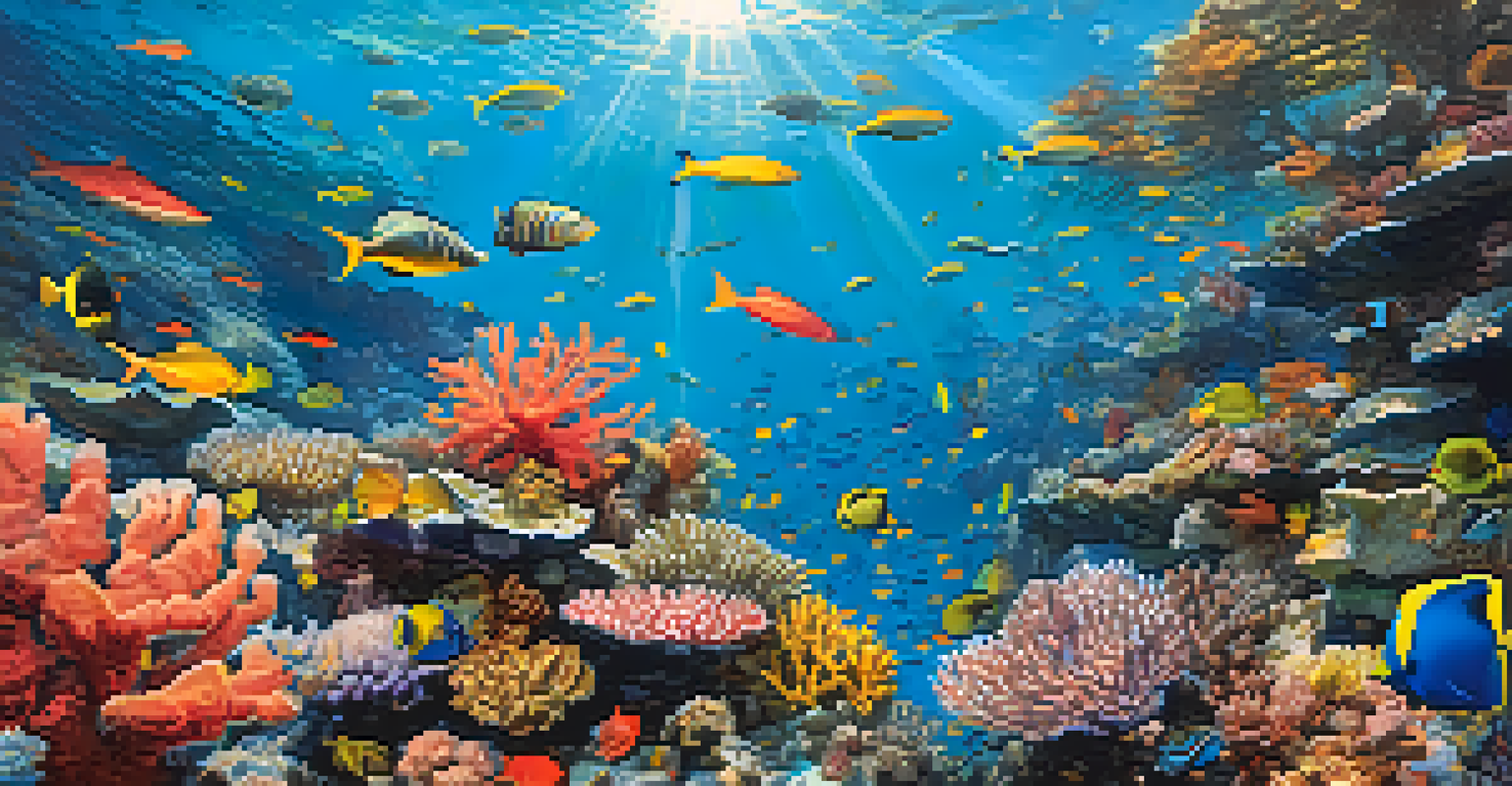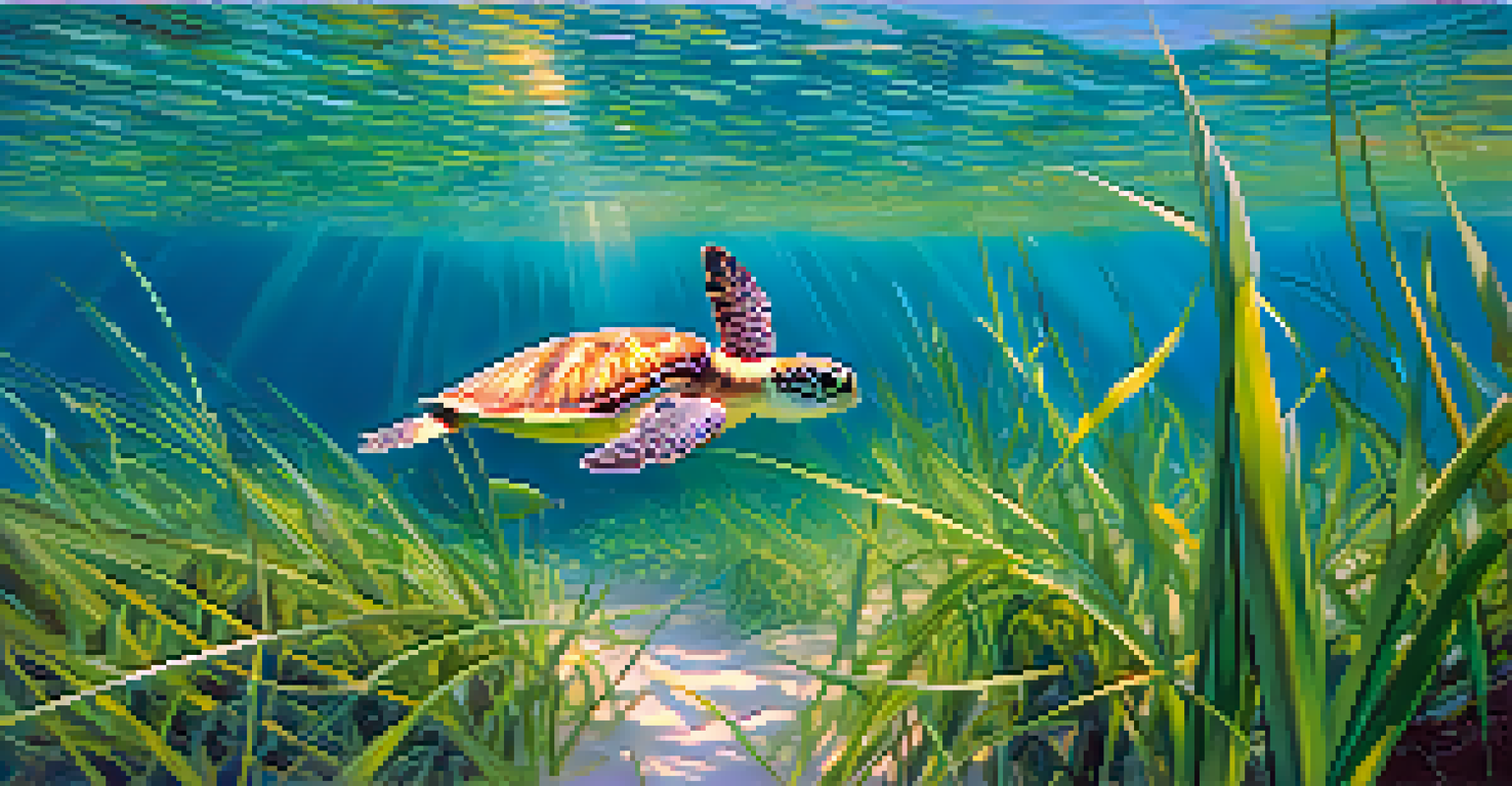The Impact of Climate Change on Florida's Coastal Ecosystems

Understanding Florida's Coastal Ecosystems
Florida's coastal ecosystems, including mangroves, coral reefs, and seagrass beds, are vital to the state's environmental health. These ecosystems provide essential habitat for a myriad of species, support local fisheries, and protect shorelines from erosion. The unique combination of warm waters and biodiversity makes Florida a hotspot for marine life. However, these ecosystems are increasingly threatened by climate change.
The health of our oceans is directly linked to the health of our planet.
Coastal ecosystems are not just beautiful; they play a crucial role in carbon sequestration, which helps mitigate climate change itself. They act as natural buffers, absorbing carbon dioxide and reducing greenhouse gases in the atmosphere. Unfortunately, rising sea levels and increased storm intensity due to climate change jeopardize their stability and functionality.
Understanding these ecosystems helps us appreciate their complexity and the urgent need to protect them. As stewards of the environment, we must recognize the interdependence between these ecosystems and human well-being. Without healthy coastal ecosystems, Florida's natural beauty and economic vitality are at risk.
Rising Sea Levels Threatening Coastal Habitats
One of the most pressing issues caused by climate change is rising sea levels, which threaten Florida's coastal habitats. As polar ice melts and ocean temperatures rise, water levels are creeping higher, submerging low-lying areas and eroding shorelines. This not only impacts wildlife habitats but also threatens human infrastructure, including homes and roads.

Mangroves, which act as natural barriers against storm surges, are particularly vulnerable to rising sea levels. When saltwater intrudes into freshwater ecosystems, it can disrupt the delicate balance that many species rely on. This change can lead to a loss of biodiversity, as certain species may not survive in altered conditions.
Florida's Ecosystems Are Under Threat
Climate change poses significant risks to Florida's coastal ecosystems, including rising sea levels and increased storm intensity.
Communities along the coast must adapt to these changes by implementing flood management strategies and restoring natural habitats. For instance, restoring mangrove forests can help buffer against rising waters while providing essential habitats for wildlife. It's a win-win situation that highlights the need for proactive measures.
Coral Reefs: The Canaries in the Coal Mine
Coral reefs, often referred to as the 'canaries in the coal mine' for climate change, are highly sensitive to temperature changes. Florida's coral reefs have faced bleaching events due to elevated sea temperatures, which cause corals to expel the algae that provide them with color and nourishment. This phenomenon threatens the entire ecosystem built around these reefs, including fish and other marine life.
In every drop of water, there is a story of life.
When corals bleach, they become more susceptible to disease and mortality, leading to reduced biodiversity in the marine environment. This decline impacts not only the aquatic life that depends on coral reefs for food and shelter but also the fishing and tourism industries that rely on healthy reefs to thrive.
Efforts to protect and restore coral reefs are critical in combating these challenges. Initiatives such as coral gardening and protected marine areas aim to bolster the resilience of coral populations. Supporting these efforts is essential for maintaining the ecological balance and ensuring the survival of Florida's iconic reefs.
Seagrass Beds: A Forgotten Hero in Ecosystem Health
Often overlooked, seagrass beds are crucial players in Florida's coastal ecosystems. They provide habitat for many marine species, improve water quality, and help stabilize sediments on the ocean floor. However, like other coastal habitats, seagrass beds are threatened by climate change and human activities such as pollution and coastal development.
As water temperatures rise and nutrient runoff increases, seagrass can become stressed, leading to die-offs that disrupt marine life. Healthy seagrass beds are essential for fish populations, as many species rely on them for breeding and shelter. Loss of these habitats could have ripple effects throughout the marine food web.
Coral Reefs Are Vital and Vulnerable
Florida's coral reefs, essential for marine biodiversity and local economies, are highly sensitive to temperature changes and face bleaching events.
Protecting and restoring seagrass beds involves community engagement and sustainable practices, such as reducing nutrient runoff from land. By working together, we can ensure the health of these vital ecosystems and the numerous species that depend on them.
The Role of Coastal Wetlands in Climate Resilience
Coastal wetlands, including salt marshes and mangroves, serve as natural buffers against climate change impacts like flooding and storm surges. These ecosystems absorb excess water and help protect inland areas from the effects of severe weather events. Their ability to hold water reduces the risk of coastal erosion and habitat loss.
Moreover, wetlands are essential for carbon storage, helping to mitigate climate change by capturing carbon dioxide from the atmosphere. The preservation and restoration of these areas are critical not only for wildlife but also for human communities that depend on them for protection and resources.
Investing in coastal wetland restoration can enhance climate resilience and support biodiversity. Engaging local communities in these efforts fosters a sense of stewardship and highlights the importance of these ecosystems in our lives and the environment.
Impact on Local Economies and Livelihoods
The health of Florida’s coastal ecosystems directly impacts local economies and livelihoods. Fishing, tourism, and recreation are heavily reliant on vibrant marine environments, which are threatened by climate change. As ecosystems degrade, so too do the economic opportunities they provide, leading to potential job losses and decreased income for families.
For instance, declining fish populations due to habitat loss can affect commercial and recreational fishing industries, which are vital to many coastal communities. Similarly, a decline in tourism due to damaged natural attractions like coral reefs can have a lasting economic impact.
Community Action is Crucial
Collective community efforts and conservation projects are essential for protecting and restoring Florida's coastal habitats.
Recognizing the connection between ecosystem health and economic stability is essential for sustainable planning. By investing in conservation efforts, communities can protect their livelihoods while fostering a thriving natural environment that supports both people and wildlife.
Community Action and Conservation Efforts
Addressing the impacts of climate change on Florida's coastal ecosystems requires collective action and community involvement. Local organizations, volunteers, and government agencies are coming together to implement conservation projects that restore and protect these vital habitats. From beach clean-up initiatives to educational programs, community engagement is key to fostering a culture of stewardship.
One successful example is the involvement of local schools in coastal restoration projects, where students participate in planting native vegetation and monitoring wildlife. These hands-on experiences not only educate the next generation about environmental issues but also empower them to take action in their communities.

By supporting local conservation efforts and advocating for sustainable policies, residents can play a vital role in preserving Florida's coastal ecosystems. Together, we can create a healthier environment that benefits both nature and the people who call this beautiful state home.